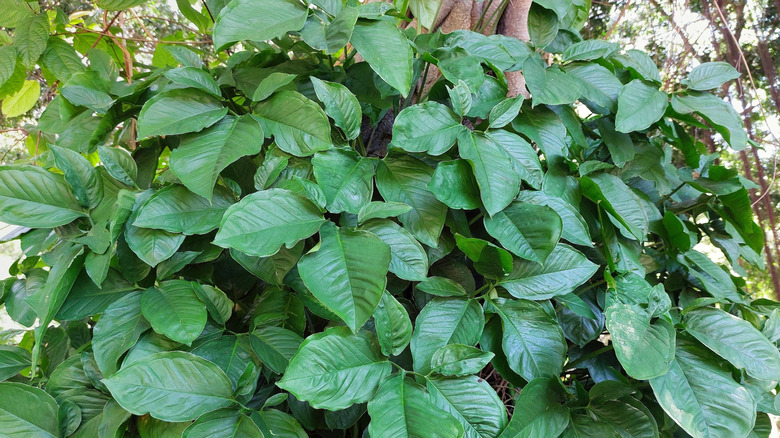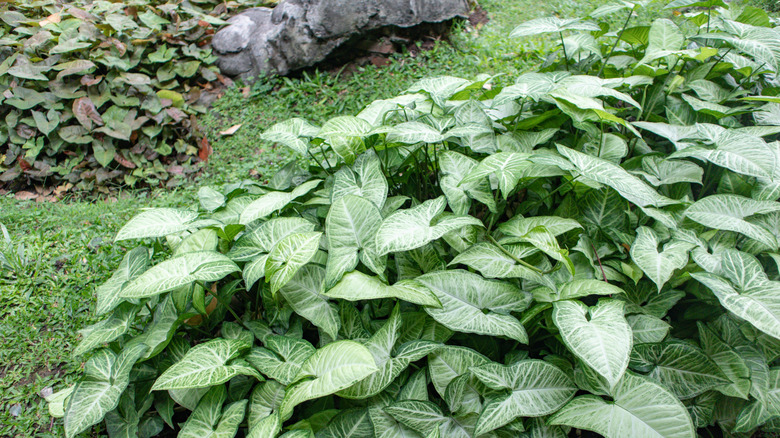The Perfect Plant For Your Humid Bathroom (No Windows Or Direct Sunlight Needed)
There are a lot of benefits to working on that green thumb by keeping houseplants. An argument for aesthetics is valid, of course, but having greenery nearby can also improve your mental health, especially during long winter months, or even help boost your concentration, memory, and productivity when working. However, not all housing situations are going to support the widest variety of home horticultural options. If you don't have much access to direct sunlight due to a lack of windows, worry not: a perfect low-maintenance houseplant exists in the arrowhead vine (Syngonium podophyllum), also known as the American evergreen.
The "American" moniker on this particular plant species is more in reference to South America, as arrowhead vines are native to the hot, humid environments of regions like Costa Rica, Guatemala, and Jamaica. That natural inclination makes the arrowhead vine a perfect candidate for growing a healthy houseplant in your bathroom; it thrives in moist environments under conditions of partial shade to dappled sunlight, so having no direct sun in a windowless bathroom is no problem. There are some warnings you'll want to heed regarding aspects like Syngonium podophyllum's toxicity, but with enough care, you'll have a perfect piece to liven up your dreary, humid bathroom.
Arrowhead vines are low-maintenance, but require some no-sun bathroom prep
Arrowhead vines thrive best in USDA growing zones 10 through 12 (only really viable in parts of Florida, California, or territories like Puerto Rico), though this arguably matters less when dealing with a solely indoor plant that's going to get much of its humid conditioning from your bathroom shower. Perhaps the most notable aspect of this herbaceous perennial is that, as with many vines, Syngonium podophyllum is a strong climber. Your growing medium should be supplemented by hanging baskets, trellises, mossy poles, or whatever you feel most comfortable training a plant to grow around. If anything, it's preferred to keep this hanging pot or trellis in a lowly-lit room because of how sensitive arrowhead vines are to direct sunlight; full sun may burn or bleach your plant if it passes over any part of the foliage.
Soil-based potting mixes that retain moisture are going to be best for your arrowhead vines, and there are plenty of ways to propagate them: division, layering, and stem cutting are all good ways to start up your new climbing houseplant — just make sure you're working in a section of your bathroom that supports up to 6 feet of potential growth. Despite being low maintenance in terms of needing no direct sunlight nor very much watering, an American evergreen should be watched for a variety of diseases common to the Syngonium genus. For example, stunted growth may be a sign of phosphorus deficiency that you can correct by enriching your soil with the right fertilizer, but you may just have to toss out your plant and start over if you see dark green spots that signify bacterial blight.
Warnings about growing and maintaining an arrowhead vine
Any plant can suffer from diseases like bacterial leaf spots that may spread to other flora in the vicinity, but arrowhead vines have a few specific concerns to keep in mind if you want to start your own tropical bathroom paradise. Namely: Syngonium podophyllum is not only poisonous to house pets like cats and dogs, it's also moderately poisonous to humans. These plants contain calcium oxalate crystals, an insoluble mineral found in over 200 plant families that's razor sharp and swells when in contact with water, causing it to stab sensitive tissue (most often in the mouth or throat). While many of its problems are the result of eating arrowhead vines, the plant can also be a source of contact dermatitis, so be careful when touching it.
As mentioned, Syngonium podophyllum only grows well in a select few regions across the United States, but its presence in Southern Florida is not a welcomed one. The American evergreen is considered a Category 1 invasive species by the Florida Exotic Pest Plant Council. They are known to displace native species and change the local ecosystem; the fact that arrowhead vines are such strong climbers means they can wrap around native trees and weigh them down, leading to greater potential dangers if that tree were to collapse. It's okay to plant some otherwise invasive species indoors, especially if it's contained to a low-light bathroom, just be careful about disposal when your houseplant reaches the end of its life.


